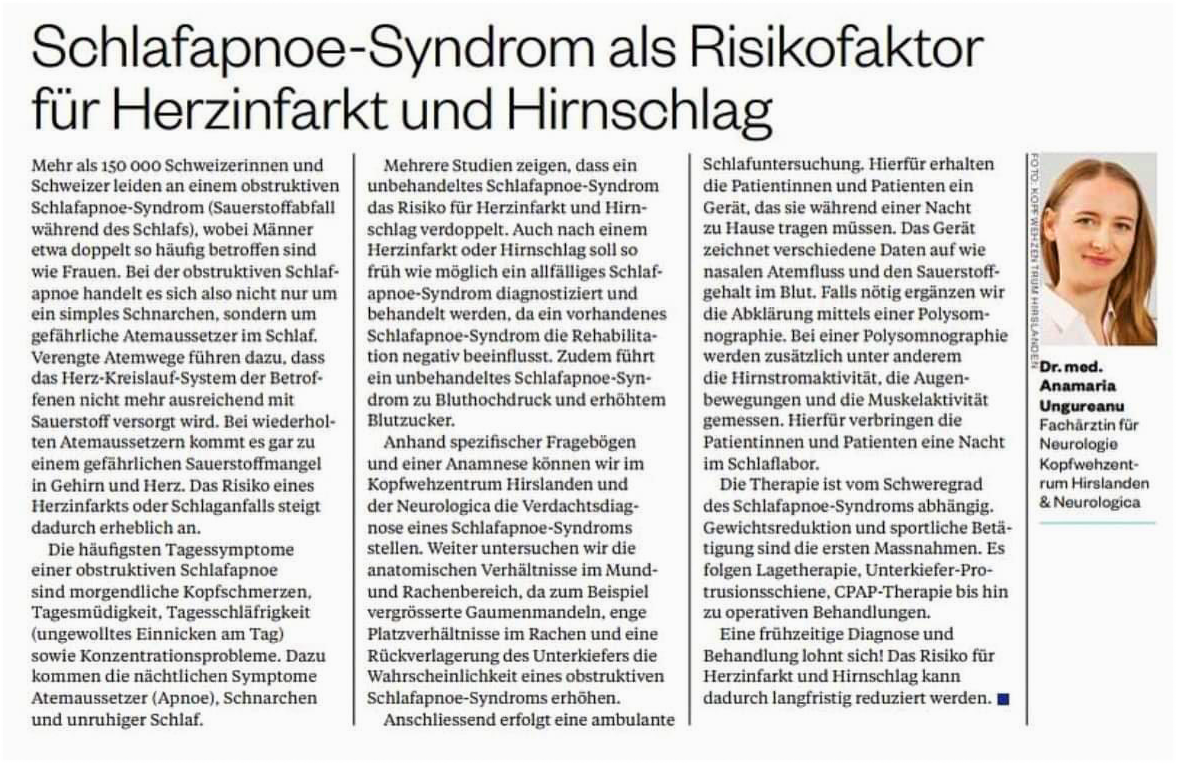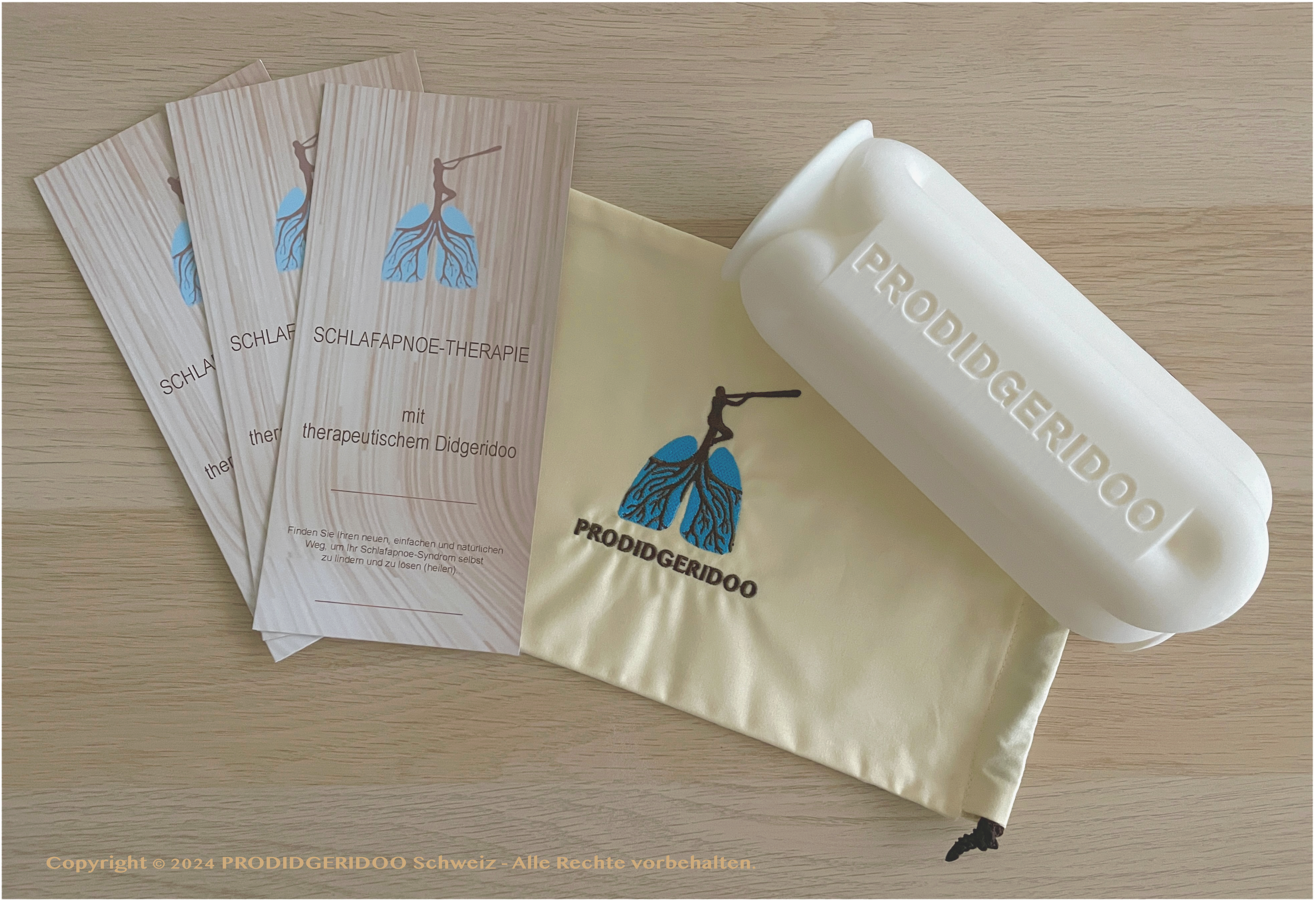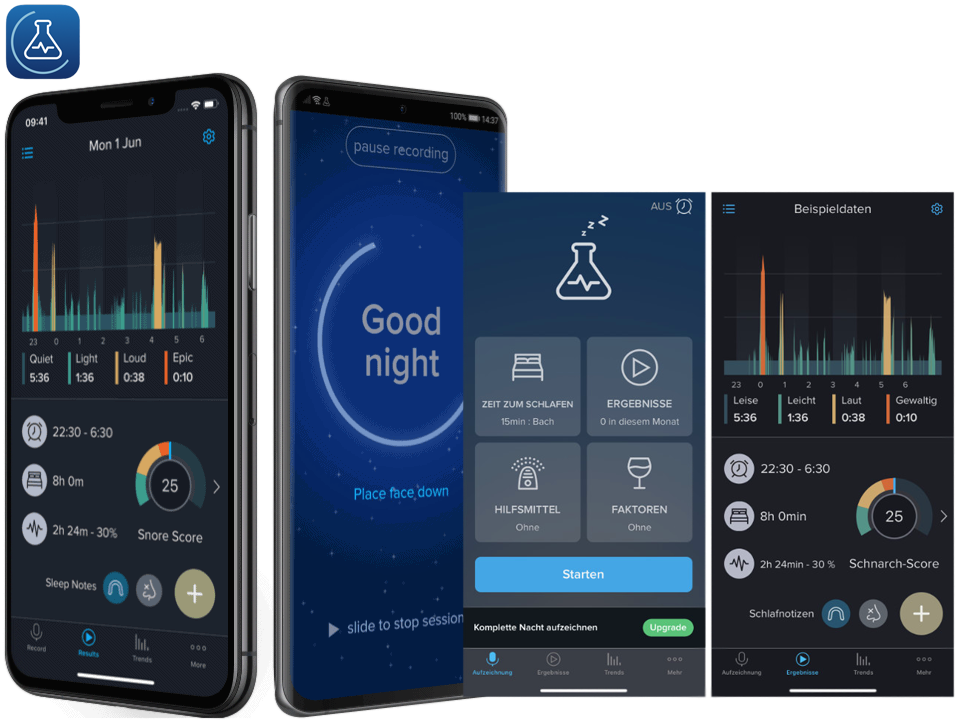General information about sleep apnea

Clarification in the sleep laboratory
As a rule, a patient stays 1-2 nights in the sleep laboratory; during this time, the reasons for the sleep disorders are determined and the optimal therapy is established. During the night in the sleep laboratory, sleep is examined by polysomnography. Various sensors are attached to the body that measure, for example, breathing, snoring sounds, brain waves, heart rate, muscle movements and the oxygen content of the blood during sleep. While you sleep, this data is continuously monitored by staff from the measuring room.

Procedure
About an hour before falling asleep, small gold electrodes are stuck to the patient's scalp to measure brain waves. In addition, electrodes are placed in the area of the outer corners of the eyes to measure eye movements, and further electrodes are placed on the chin to measure muscle activity. A nasal cannula and a breathing sensor attached between the mouth and nose are used to detect snoring or sleep-related breathing disorders. Breathing belts across the chest and abdomen record breathing movements, while a small snore microphone is attached to the neck. Pulse and oxygen saturation are measured via a pulse oximeter attached with a finger clip. EMG electrodes attached to the lower legs allow recording of movements. An ECG logs nocturnal cardiac activity or possible nocturnal arrhythmias.
- A night in the sleep laboratory (KSM Clinic for Sleep Medicine, Bad Zurzach and Lucerne)
Here you will find medical advisors as well as addresses of doctors, clinics and sleep laboratories in your area (Switzerland).
During nighttime sleep, various functions of the body are monitored and subsequently evaluated. These include:
- brain activity (EEG)
- muscle activity (EMG)
- cardiac rhythm
- leg movements
- breath movements
- body position
- breath flow
- breathing noises (snoring)
- oxygen saturation in the blood
Often, an ambulatory measurement of certain functions is already performed in advance (e.g., of pulse rate, oxygen saturation of the blood, respiratory movements and respiratory flow). This can be done at home with the help of a mobile device.
Evaluation of obstructive (and central) sleep apnea
During an outpatient polygraphy, one or two nights are spent measuring whether breathing stops occur and whether there is a relevant drop in oxygen levels in the blood. So if your sleep is accompanied by nocturnal breathing interruptions or heavy snoring with daytime sleepiness, an outpatient polygraph examination should be carried out on you (at home or in a sleep laboratory).

Here is an example of a polygraph


What is sleep apnea?
Sleep apnea is a life-threatening condition that can be recognized by loud snoring and breathing stops during sleep. Patients themselves are not aware of these hallmarks, but the partner of someone with sleep apnea usually suffers greatly from their loud snoring - separate bedrooms are often an unmistakable sign of sleep apnea. Obstructive sleep apnea is a slackening of the connective tissue and muscles in the throat and pharynx. This causes the upper airways to close during the night and this closure causes the oxygen level in the blood to drop.
Sleep apnea is a nocturnal breathing disorder. There are two different forms of this sleep disorder. The causes of sleep apnea are varied. However, if sleep apnea remains untreated over a long period of time, serious secondary diseases can develop.
1. Breathing pauses and snoring
Sleep apnea symptoms that indicate the condition at night are usually not noticed by the sufferers themselves. It is often the partner who observes both the characteristic snoring and the breathing pauses. Typically, an affected person snores regularly until breathing then stops in between for seconds or minutes, only to resume with a loud, often crashing, snoring or breathing sound.
2. Daytime sleepiness
The most common sleep apnea symptom, noticed by the sufferer himself, is daytime sleepiness. Those who repeatedly wake up in between at night do not get enough rest. This affects the day, where, depending on the severity of the apnea, severe fatigue can sometimes occur.
3. Microsleep
If sleep apnea is particularly severe, fatigue can go so far that sufferers fall asleep or nod off for a few seconds during the day. This is particularly dangerous when people suffering from microsleep are in traffic or operating machines, for example at work - serious accidents can result.
4. High blood pressure and cardiac arrhythmias
In the long term, breathing pauses during sleep can cause problems related to the cardiovascular system. If breathing repeatedly stops at night, the body is put on alert, activating the autonomic nervous system, which regulates blood pressure. This can cause the blood pressure to rise, leading to high blood pressure and secondary diseases such as heart problems - for example, cardiac arrhythmias.
5. Poor performance and headaches
If you are tired and listless during the day, you cannot perform at your best - whether at work or in everyday life in general. In addition to a drop in performance and lack of concentration, headaches can also occur because the body lacks rest. Memory also suffers from interrupted sleep phases.
6. Depression and potency disorders
Daytime sleepiness and the occurrence of other symptoms of sleep apnea mentioned here can have a negative effect on the entire psyche. Depression and potency disorders can be the result, as the quality of life is affected by the sleep disorder, depending on its severity.
Different types of sleep apnea
The term apnea means "non-breathing" or also respiratory arrest. Sleep apnea or sleep apnea syndrome (SAS) is a breathing disorder that occurs during sleep. A distinction is made between obstructive and central sleep apnea, which occur in a ratio of approximately 90:10.
Central sleep apnea is a disorder of the respiratory drive that results from damage to the brain or systemic disease. The brain can no longer adequately control the respiratory muscles during sleep. This leads to reduced breathing or temporary respiratory arrest.
In this form of sleep apnea, the tongue muscles and surrounding tissue slacken during sleep. The upper airways are thus closed and breathing stops for a longer period of time. As a result, oxygenic air can no longer reach the lungs in sufficient quantity. The lack of oxygen leads to frequent waking reactions during the night.
Depending on how often these breathing pauses occur per hour, obstructive sleep apnea is divided into three degrees of severity:
- Mild OSA* (more than five to 15 pauses in breathing per hour)
- Moderate OSA* (15 to 30 breathing stops per hour)
- Severe OSA* (more than 30 breathing stops per hour)

In many cases, sufferers are not aware of these nocturnal waking episodes, making it difficult to diagnose sleep apnea. The dangerous breathing pauses are often only recognized by the partner of the affected person.
OSA* = obstructive sleep apnea
ZSA = central sleep apnea
SAS = sleep apnea syndrome
Causes of obstructive sleep apnea
Anatomically, the tongue is attached to the lower jaw. However, if the lower jaw is too small and has not grown forward enough (backward position of the lower jaw), the tongue also lies too far back and blocks the airways due to lack of space. Patients cannot sleep in the supine position because the tongue falls backwards and blocks the airways like a cork.
The consequences of sleep apnea

Sleep apnea is a serious disease!

If left untreated, sleep apnea can have serious consequences (various secondary diseases). In addition, those affected suffer from daytime sleepiness due to the numerous nighttime awakenings and are sometimes severely restricted in their daily lives. The frequent daytime sleepiness has another dangerous consequence that affects not only the sufferer - Microsleep. In this case, the affected person falls asleep and then wakes up again a few seconds later. Depending on the situation, microsleep can cause serious traffic and work accidents.
Consequences of the lack of oxygen can be:
![]() daytime fatigue
daytime fatigue![]() exhaustion
exhaustion![]() constant tiredness
constant tiredness![]() concentration deficiency
concentration deficiency![]() microsleep e.g. at the wheel
microsleep e.g. at the wheel![]() depressions
depressions![]() high blood pressure
high blood pressure![]() diabetes
diabetes![]() cardiovascular diseases
cardiovascular diseases![]() cerebral stroke
cerebral stroke![]() and much more...
and much more...
The life threatening consequences of obstructive sleep apnea are due to the lack of oxygen in the blood. The lack of oxygen during sleep can lead to the death of brain cells. Daytime sleepiness, falling asleep in front of the TV or while driving, lack of concentration, severe drop in performance are alarm signs that suggest sleep apnea. Patients, who are often overweight, suffer from high blood pressure and are at high risk of heart attack and stroke.
The CPAP mask
CPAP ventilation, also known as CPAP therapy (abbreviation for "continuous positive airway pressure"), is a form of ventilation that combines the patient's spontaneous breathing with a permanent positive airway pressure (PEEP) maintained during inhalation and exhalation. The patient can determine his or her own breathing depth, breathing rate and also flow (air flow). The prerequisite for the use of CPAP ventilation is therefore the patient's basic ability to breathe on his own.
Execution
CPAP therapy is also used to treat temporary cessation of breathing during sleep in sleep apnea. In CPAP therapy, patients are continuously supplied with breathing air (ambient air) at a slight positive pressure during sleep. Usually, the air is sucked in by a CPAP device next to the bed and supplied to the sleeper via a tube using a full-face or nasal mask (nCPAP mask n=nasal). Depending on the findings (medical history) and any existing impairments to lung function, the air supplied is also heated and humidified.
Diagnosis and therapy for this is generally first initiated with a mobile breathing monitor that can be used at home, and then established during several overnight stays in a sleep laboratory, where several wired sensors attached to the body measure respiratory arrest and blood oxygen levels overnight in particular. Eye movements are measured to monitor REM sleep and other sleep phases, and brain waves are also derived. If the diagnosis is confirmed, a gradual approach to an individual therapeutic pressure is made. Too high a pressure may cause compressed air to escape through the mouth again immediately or, in the worst case, may interfere with spontaneous breathing.
Side effects of the CPAP mask
- pressure on cheekbones
- dry mouth and nasal mucous membranes
- dry eyes and eye irritation
- slippage of the mask
- and more...

Patient during sleep with a CPAP mask.
Detailed information on asthma, Long Covid and COPD can be found here (below).
Did you know that the PRODIDIDGERIDOO therapeutic instrument helps against these complaints and diseases?
- Snoring, apnea
- Asthma, Long Covid
- COPD
- a.o.
Alternative therapy also for:
![]() visually impaired and blind people
visually impaired and blind people
Visually impaired and blind people can also attend the therapy. A special tool is included to support the therapy and in the documentation.
![]()
![]() Asthma, Long Covid and COPD diseases
Asthma, Long Covid and COPD diseases
Asthma
Not all asthma is the same, there are 3 different types:
- Allergic (extrinsic) bronchial asthma
- non-allergic (intrinsic) bronchial asthma
- mixed form
In the past, asthma patients were advised to avoid all exertion. It is now known that it can be helpful for asthma patients to train their breathing muscles. Studies have shown that playing the didgeridoo can significantly improve lung function. It has also been shown that children and adults suffering from asthma who play wind instruments are less likely to experience a worsening of their condition. Playing wind instruments has also been shown to improve lung function in healthy test subjects.
Long Covid
Long Covid syndrome can develop after an infection with the SARS-CoV-2 virus, which causes the disease Covid-19. The course of the infectious disease can vary greatly. In severe cases after infection, it can lead to inflammation, vascular occlusion and oxygen deficiency in various organs. The lungs, heart, blood vessels, kidneys and brain are frequently affected. If organs are damaged long-term or permanently, this is referred to as post-Covid syndrome. However, even relatively mild cases of Covid without severe organ involvement can lead to long-term problems, which are then referred to as "Long Covid".
COPD
Chronic obstructive lung disease (COLD) or chronic obstructive pulmonary disease COPD is a progressive, not completely reversible obstruction - narrowing of the airways. COPD is not a disease in its own right, but is a combination of chronic obstructive bronchitis - inflammation of the bronchi of the lungs - and pulmonary emphysema - abnormal increase in the air content of the lungs. However, bronchial asthma is not included in the definition of COPD.
This alternative therapy is also very suitable for lung patients suffering from asthma, Long Covid or COPD (chronic obstructive pulmonary disease). The vibrations of the therapeutic instrument and the effective breathing and playing technique intensively train and strengthen the lungs, abdominal breathing and diaphragm. This therapy increases the effectiveness of lung rehabilitation and physical resilience.
Throat cavity
Endoscopy
During training with therapeutic didgeridoo.
(Images of my throat, ENT practice, Sarnen, Switzerland)
Get more information about sleep apnea syndrome (SAS) here.
For information, dates and registration for snoring and sleep apnea therapy, you will get here.
![]()
New and unique therapeutic instrument
Latest technology for snoring and sleep apnea therapy!
PRODIDGERIDOO works with the latest technologies in order to remain flexible and innovative. This brings many benefits for patients and clients. Learn more about these innovative approaches.
The new therapeutic instrument (ApnoeDidge 3D) from PRODIDGERIDOO was specially developed for snoring and sleep apnea therapy and is a therapeutic product that has been continuously improved, further developed, researched and proven. In just a few days (or weeks), you can sleep relaxed and relaxed without snoring, without sleep apnea, without a splint and without a CPAP mask. This therapeutic instrument is very light (a few grams), handy, practical, efficient, requires no maintenance, is environmentally friendly and is biodegradable! This little wonder can easily be stored in a ladies handbag, backpack, sports bag and suitcase. The therapeutic instrument is also very suitable for traveling!
Film - Production of new ApnoeDidge 3D (2025) / Presentation ApnoeDidge 3D (2024)
The new design of PRODIDGERIDOO's therapeutic instrument is made to be easy and relaxed to learn for all users. In order for this alternative therapy method to be successful, special demands are placed on the therapeutic instrument!

ApnoeDidge 3D (2025)
Audio sample
![]()
Audio sample of the therapeutic instrument.
![]()
A recommendation that is worthwhile!
A recommendation that is worthwhile for you!
Who else should be able to benefit from this alternative therapy (snoring and sleep apnea)?
Would you like your colleagues, acquaintances or relatives to contribute to their health and healthy, restful sleep? You will receive CHF 40.00 (per patient, client) directly into your bank account for each successful referral. The transfer will only be made once the person you have recommended to PRODIDGERIDOO has also officially attended sleep apnea therapy.
Details of the recommendation can be found in the form (PDF format). Of course, the recommendation is non-binding. Please complete the form legibly and return it by e-mail to info@prodidgeridoo.com with the subject "Recommendation", thank you. - Thank you for your recommendation.
Snore analysis app

Do you suffer from snoring, sleep problems, lack of sleep or perhaps sleep apnea syndrome?
The "SnoreLab" app can give you an idea of the duration and intensity of your snoring. You can record and track your snoring and monitor your sleep rhythm. If you suspect you suffer from sleep apnea, be sure to see a doctor. A serious measurement must be performed with a mobile measuring device at home or in a sleep laboratory.
The snore analysis app "SnoreLab" for your smartphone can be downloaded here (free):![]()
![]()
Media
- Booouuuuuoooh!
(GlücksPost, 22.07.2021) - Blasrohr therapiert das Schnarchen
(SempacherWoche, 21.03.2019) - Reportage - Schlafapnoe
(TELE Z, 30.10.2017) - Didgeridoo hilft gegen Schnarchen
(Blick am Abend, 15.09.2017)

Abzocke bei Prämiengeldern, bei CPAP-Masken
(Berner Zeitung, 26.02.2024)
